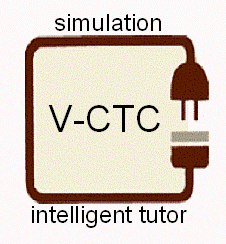|
V-CTC
Virtual Combat Training Center A simulation without a tutor is like a CTC without an O/C. |

|
|
V-CTC
Virtual Combat Training Center A simulation without a tutor is like a CTC without an O/C. |

|
A: At the risk of oversimplifying...
A: No, CTCs (combat training centers) are used in other services, too, such as the Navy's Top Gun schools and the Air Force's Agressor Squadron. The V-CTC concept is intended to apply to all services, not just one.
Q: Is V-CTC only applicable to NTC training?
A: No, just because the first demonstration of the V-CTC concept is with the Army's CTC at Fort Irwin, that does not mean that other V-CTCs could not be developed for other Army CTCs or for other defense services.
Q: Can V-CTC be used with the HLA architecture?
A: Yes, there is nothing in the design or approach that prevents deployment in an HLA environment. We picked an initial implementation in a simple non-HLA enviroment so we could focus on the tutorial problems and demonstrate the proof of concept, first. Additional work would be required to plug into HLA, but this work should be relatively minor compared to the overall cost of developing an intelligent tutoring system or a high-fidelity simulation and integrating the two conceptually and in terms of software communications.
Q: Is V-CTC just some abstract concept?
A: No, it has been implemented as an intelligent tutoring prototype capable of teaching two duty positions to various degrees of ability. It is best able to teach the BN FSO (battalion fire support officer) position. It also provides support for a armor or mech company team commander position, but to a much lesser degree.
Q: So what's different about it? Haven't intelligent tutoring systems been built before?
A: Not many and not many are deployed as they are very expensive. What is different about this is that it is made of two separable modules: one part is a high-fidelity simulation, and one part is tutoring system. The simulation was developed before the tutoring system and continues to be improved independently. Thus the simulation component continues to get better and there is already a community of users interested in interacting with the simulation. Similarly, the tutoring component has advantages in being separate: It can be plugged into other simulations, including simulations for other CTCs or other services. This ability to separate and independently improve the two major components of an intelligent simulation-based training system allows both to improve through the actions of separate communities and allows for cross-fertilization of the products of the different communities in unexpected and beneficial ways. The net result is that the cost of each can be amortized more efficiently over more training applications: the same simulations and tutoring components used in different combinations for classroom, research, individual training, embedded training, and for providing ongoing training products that arrive at the same time as newly developed lines of weapons or modifications.
Q:Separating the simulation component from a tutoring component seems like a good idea, perhaps obvious in retrospect. Is that all there is to V-CTC?
A: No, a mere separation would not ensure reusability. Steps toward a standardized means of connecting the simulations and tutoring components further facilitate the integration, but even that is not enough: that is similar to providing a standard kind of phone jack. Standard protocols for communicating event information and more importantly knowledge between simulations and tutoring systems are required.
Tutors and simulations model different kinds of things. Simulations model physical systems; tutors model teaching behavior and cognitive learning systems. One models things, the other models thinking.
There is overlap in that the tutor must be able to track the important events that occur in the simulation and be able to talk about them. It must know about the domain objects, but in a different way than the simulation does.
V-CTC uses an ontology to provide a means of integrating the knowledge that the simulation has about its domain concepts and the tutor has about its tutorial concepts. The ontology also provides a means of allowing knowledge to be reused across tutoring systems.
By analogy the ontology exists at a higher level independent of the lower level implementation of the event stream protocols or actual physical connection between the simulation and tutor, just as an Internet application can be implemented with different lower level socket libraries or on different networking systems.
With the ontology much of the information developed in one CTC application can be applied to similar CTC applications allowing families of tutors to be developed, thus amortizing the application cost across all the tutors.
Email: wrmurray@earthlink.net